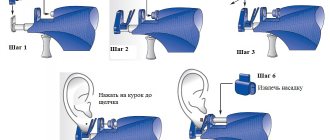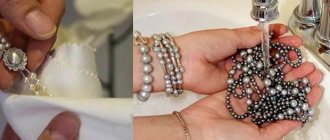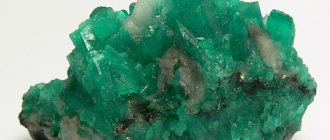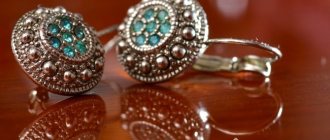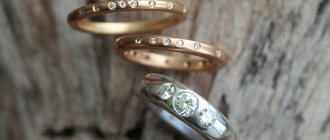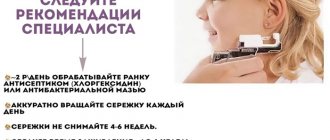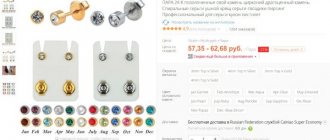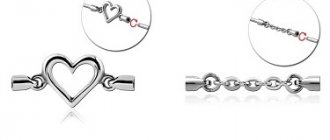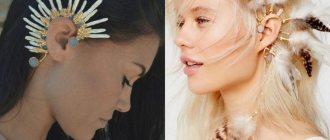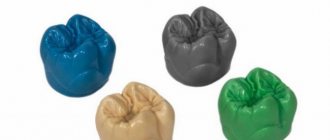Piercing the earlobe with a gun
Technique for ear piercing: “cock” the pistol and “load” the earring into it (the technique of this procedure is described in great detail in the instructions for the pistol).
The gun has a free stroke, during which there is no click. This is necessary to fix the earlobe and bring the tip of the needle earring to the intended puncture point. If everything is ready and the point is at the tip of the needle, we overcome the resistance of the “trigger” and the gun fires. The earring is fastened in the ear. Using a downward movement, remove the gun from the earlobe.
What does medicine say?
It’s worth mentioning right away that official medicine does not tie the ear piercing procedure itself to an age limit, or even to the exact location for the piercing. The only restriction that Western medicine recommends is that ear piercings should not be given to children under one year of age. This is due to the development of the body, the formation of the shape of the ears, therefore, punctures at this age can adversely affect the very course of this process. But, if you rely on such recommendations, you can cause harm to yourself, for this reason, you should definitely look at the peculiar “acupuncture points”, and you need to focus on them.
From the point of view of alternative oriental medicine, the ear is not “just an ear” - an organ of hearing, but also a rather powerful acupuncture system, the impact of which is directly related to the internal organs, their proper functioning and reaction to difficult environmental conditions. If you select (without piercing) certain “reflexogenic zones” in the area of the auricle and stimulate them, this will have a positive effect on the functioning of individual internal organs. This technique is actively used in their work by specialists in the field of acupuncture. Such an attitude towards the issue of where to pierce the ears indicates the need to take care of the ears of adults, and especially children.
Traditional puncture sites
According to the established “tradition,” ear piercing is done in the area of the lobe. Based on the postulates of the same oriental medicine, it is worth saying that this is the right decision, because in the area of the earlobe there is a minimum number of active points (hence, the chance of “getting to the wrong place” is reduced to a minimum). In addition, it is noted that there is no cartilage in the area of the earlobe, pain is minimal, and healing occurs in the shortest possible time.
Specialists in the field of reflexology have even developed a separate cartography of the human ear, indicating on it parts of the body and internal organs, onto which individual channels can be projected and the possibility of influence analyzed. As it turns out, on the ear alone there are about 356 points, among which there are only 11 on the earlobe. Among the most important points of correspondence, on the earlobe you can find points of the eye, lower and upper jaw, palate, tonsils, and even individual channels that directly affect on the brain activity of the piercing owner.
So, from an aesthetic point of view, the best option is considered to be the very middle of the lobe, as close as possible to the cheek area. This place is distinguished by the following:
- There are no serious acupuncture points in the specified area of the ear; the likelihood of getting on the canal leading to any organ is minimized;
- There is no cartilage, therefore, painful sensations do not bring significant discomfort. In addition, rapid tissue tightening is observed;
- When wearing earrings in this place, the effect of “rejection” rarely occurs; the tissues quickly adapt to the metal and there is no irritation on them.
Based on the opinion of neurologists, it is worth noting that even if you accidentally touch one of the points located in this area with a needle, it will stop stimulating a specific organ, but will not cause serious harm or even discomfort, since it is not the main one.
Are there any contraindications for piercing?
There are several main contraindications for piercing: Age. How long can you start getting a piercing? By law, piercings can be done from the age of 16 in the presence of a parent or legal guardian. Pregnancy. In the early and late stages, stress during the piercing procedure can affect the course of pregnancy (during lactation you should also refrain from piercing). Heart disease. Before the procedure, you should definitely consult your doctor. Contraindications to piercing can also include chronic skin diseases, kidney failure, cancer, in which case a consultation with a doctor is required.
Cartilage Piercing Care
Medicines for puncture treatment
Let's name proven drugs that help disinfect the puncture site and speed up healing:
- 3% hydrogen peroxide solution;
- Levomekol (ointment against suppuration);
- Chlorhexidine bigluconate (disinfectant solution);
- Baneocin (powder preparation);
- Miramistin (used after cleansing with peroxide, when you need to remove particles of blood and secretions);
- Dioxidin and Octenisept (used strictly as prescribed by the specialist to cope with complications).
We have listed common pharmaceutical medications, but in each case the approach is individual. You just need to follow all the recommendations of your master. A specialist knows better how to treat an ear piercing depending on the characteristics of a particular piercing.
Days style cartilage piercing, short straight barbell with balls
blue tragus style flower piercing and 2 small studs in the lobe, cartilage piercing, colored straight short barbell with balls
Is there a risk of contracting hepatitis or HIV?
Do not get piercings in questionable places, at home, in a club, etc. The master must work in disposable, clean gloves, and the instruments must be sterile. If you are worried, the technician can remove tools from an autoclave or ultraviolet cabinet in front of you . If all hygiene standards are followed during the procedure, everything will be fine.
Does the piercing take a long time to heal?
The complete formation of the canal for many punctures takes on average 6-8 months (with the exception of tongue and smile, they heal much faster), but this does not mean that the puncture will hurt throughout this time. If you follow all the recommendations and proper care, the pain goes away after 2-4 weeks.
Prevention
Preventive measures are aimed at minimizing the possible negative consequences after ear piercing. The main actions that should be performed regularly if you have holes in your ears are the following:
- When changing jewelry, it is necessary to disinfect the inserted jewelry and wipe the holes with an antiseptic.
- During the cold season, it is recommended not to wear massive jewelry with pendants or an abundance of decorative elements to prevent hypothermia.
- It is recommended to remove earrings from your ears while sleeping, taking water procedures and swimming in open water.
- It is advisable to avoid touching earrings and holes with dirty hands; if touching is necessary, you must first wash your hands with antiseptic soap.
- When wearing earrings for a long time, the jewelry needs to be cleaned periodically - approximately once a week.
- It is recommended to choose jewelry from hypoallergenic metals and materials - silver, titanium, gold, copper steel and bioplastic.
- You should maintain ear hygiene - wash them regularly and clean them carefully, without using sharp objects - so as not to damage your hearing organs.
If you want to perform an independent puncture, no matter - with a needle or a gun, you need to carefully work out and think through the puncture process, as well as prepare everything necessary to complete the procedure. You first need to familiarize yourself with the diagram, which shows the location of physiologically important points on the auricle. All instruments must be sterile and subsequent care must be carried out accurately and in a timely manner.
Preparing for a puncture
Preparing for a puncture involves purchasing the necessary instrument, suitable jewelry and disinfecting it. The following is required before piercing:
- sterile gloves;
- medical alcohol;
- decoration made of hypoallergenic material;
- cotton sponges;
- disposable needle or piercing gun;
- hydrogen peroxide 3%;
- antibacterial soap;
- Chlorhexidine.
Before actually piercing your ears, you need to wash your hair, since in the next few days you need to protect the piercings from water.
What piercing is in fashion now?
Previously, piercing was considered an attribute of informals, but with the development of the piercing and body modification industry, this opinion has completely changed. Is piercing fashionable? Of course yes! Manufacturers of piercing jewelry create forms of products that look sophisticated, and everyone can find something that will perfectly highlight their individuality. The most fashionable piercing at the moment is the piercing of the wing of the nose and microdermal. These piercings have not lost their popularity for a long time, and are suitable for absolutely everyone. But the fashionable piercing of 2021 is, perhaps, the helix and conch piercing, which look harmonious in any look.
Features of ear piercing
If you approach the issue responsibly and choose a knowledgeable specialist in this field, wearing earrings will even bring tangible benefits to your body. It is believed that in this way you can even try to correct your vision. But, you need to be careful, because according to Eastern beliefs, you only need to insert “your own metal” into the ear, otherwise, an imbalance in the energy balance in the body may occur. For example, problems will begin with the functioning of the vascular, digestive, nervous and other systems of the body, and the person himself will gradually experience discomfort, problems with fatigue, malaise, and sleep will deteriorate significantly.
Now the most important question is how to do such a puncture correctly? As practice shows, not in all cases, after an incorrect puncture, the body will immediately make itself known. An unsuccessfully pierced place will transmit an impulse through the channel to a specific organ and it will begin to work unstably. Initially, this manifestation will not be of such a catastrophic nature, but after a long time (although, depending on the situation, the first problems can be observed already during the first year), certain organs will begin to “fail,” and a deterioration in tone will be observed.
Where to go for advice?
The best option for resolving the issue of choosing a puncture would be a reflexologist. His task comes down to not just studying the location of points on a topographic map of the body and finding the best place for a puncture, but also linking traditional data to the morphology, individual features of the body structure of the client who contacted him. The bottom line is that there are many acupuncture points on one centimeter, the slightest deviation to the side can lead to damage to the channel - this is unacceptable. There is no need to try to find such points on your own; this cannot be done with a 99% guarantee, but the risk of harm to the body is enormous. It is worth noting a number of characteristic contraindications:
- It is not recommended (even prohibited by both Western and Eastern medicine) to pierce the ears of those who have suffered from eczema in the past. Otherwise, your health may deteriorate and new, no less serious complications may arise;
- The category of diseases that prohibit ear piercing usually includes cystic acne, complex blood diseases, and allergic disorders regarding metal and its derivatives.
If it is not possible to provide adequate levels of sanitation and care after a piercing procedure, it should not be done. For example, in the future some complications may arise, which manifest themselves in the form of keloid scars and numerous infectious disorders and allergies.
A separate issue is the allergic reaction of individuals to various metals. It is worth considering that there are simply no non-allergenic metals (regardless of whether the earrings are made of gold or silver). It is an erroneous opinion that earrings of 750 and 583 purity gold are completely safe, but this is far from being the case as many women who decide to pierce their ear area see it. For example, these samples contain a strong allergen - nickel, which has a negative effect, especially when it comes to irritated skin. Just nickel is enough to cause a severe allergic disorder on the surface of the skin. When any complication occurs, you should immediately consult a doctor to prevent serious problems from occurring.
How to properly pierce your ears
best age
Let’s say right away that there is simply no best age at which to pierce a child’s ears. For example, some experts believe that it is easiest to do this before one and a half years, when the child does not experience a feeling of fear and quickly forgets about the pain. That’s how it is: the little ones instantly forget about the procedure and how their ears healed after the piercing. But on the other hand, a little girl is not always able to control her movements and can catch an earring and injure her earlobe. In addition, it is more difficult for young children to treat their ears after a piercing: they simply do not understand why they have to endure sometimes unpleasant procedures. Therefore, there is another opinion: ears should be pierced when the child himself asks to do it.
Then the girl will already understand why they do this to her, and it will be easier to care for her ears. Well, be that as it may, only the family decides at what age to pierce a child’s ears.
where to get your ears pierced
Now you can get your ears pierced in almost every medical center or beauty salon. But it’s still better to do this in a place where there is a license for medical activities, and a children’s clinic would generally be an ideal option.
Firstly, in a clinic a specialist (doctor or nurse) will most likely be more qualified than in a simple beauty salon; secondly, in a children's institution, employees have experience in how to communicate with a small child (after all, a girl may get scared and cry during the procedure). Well, and most importantly, in medical institutions they still take hygiene and compliance with sanitary standards more seriously, and there is a larger selection of different devices for punctures. In addition, a specialist with a medical education will always tell you exactly how to properly care for the puncture site, what should be used to treat it, and what not to do.
how to pierce
The most modern way to pierce ears is a special “gun”. The ear is pierced with disposable needle earrings
(as if shot through), and the earring remains exactly at the puncture site. Such earrings (in the form of “studs”) become the first for a girl. The manipulation lasts a matter of minutes and is practically painless. But sometimes the child gets scared by the characteristic sound that the “gun” makes when piercing, cries and even refuses to pierce the second ear. Therefore, now an even more advanced model of the “pistol” has appeared, which operates on a different principle. During a puncture, the tissues of the earlobe seem to move apart, so the manipulation itself becomes even less painful and almost silent. Well, the old method of piercing the ears with a (sterile) needle is no longer used almost anywhere: it is both inconvenient and painful, and you may not get into the precisely chosen place.
choice of earrings
While the child is small, earrings “for every day” should be as light as possible, without additional decorations or pendants. Otherwise, heavy earrings will pull down your earlobe. In addition, long dangly earrings make it easier to snag clothes or simply touch them while playing, which means somehow damaging the earlobe. So the best option for everyday jewelry is stud earrings, but for a holiday you can wear something more intricate.
One more thing to consider is the material from which the earrings are made. Usually, the very first children's earrings are made of medical alloy (it is less allergenic).
But silver is not suitable for the first puncture - it actively oxidizes upon contact with human blood and lymph, as well as upon contact with some antiseptics (the jewelry itself and the skin around it turn black).
Well, what to wear in the future when the ears heal -
gold, silver, platinum or just jewelry - you can’t guess, the material will have to be chosen by trial and error (the reaction can be to any metal).
when you don't need to pierce your ears
There are situations in which it is not worthwhile to pierce a child’s ears: for example, if a girl has a predisposition to keloids or the wounds do not heal well; if she has recently suffered from an infectious disease or feels unwell; if there is an allergy to metals, and simply if the child does not want or is afraid to do it yet. It is also better
not to pierce your ears in extreme heat: the piercing site may take longer to heal.
There are children who do not like to wear a hat in winter and constantly strive to take it off, then it is better to postpone ear piercing until the warm season: after all, often taking off the hat, the baby can touch the piercing site. after a puncture
The ears are pierced, the earrings are inserted, now we just have to wait for the holes to heal. What to do to make this happen quickly and without complications:
- – in the first 2–3 days, it is better not to wet the puncture site with water;
- – try not to touch the ears with clothes, and do not let the child touch them with his hands;
- – monitor the condition of your ears and regularly treat them with antiseptics. Usually, for 2-3 weeks, the puncture site and the earrings themselves are treated with antiseptics 3-4 times a day, without turning the jewelry. There is another way to care for your ears: seal the puncture site with medical glue, thus securing the earrings, and do not touch or twist them until the glue gradually comes off on its own. After this, the earlobes are wiped daily with disinfectant compounds until complete healing. The ear piercer will determine which method of care to choose. The earrings are not removed until the holes are completely healed.
If you get your ears pierced by a good specialist and then take proper care of them, they will heal quickly and without complications. And the result will undoubtedly bring pleasure to both the parents and the girl herself.
What complications and consequences can there be after piercing?
If you follow all care recommendations, the likelihood of complications after piercing is very low. Most often, problems in healing arise due to mechanical trauma, that is, if you catch or pull the jewelry, then inflammation of a fresh puncture is inevitable. Complications after piercing can also occur if you have a weakened immune system, or if the piercing was done during a cold. You should do piercing with caution if you have dermatitis, psoriasis, seborrhea, lichen and other skin diseases; it is better to consult a doctor before the procedure, otherwise the consequences of an unsuccessful piercing will take a very long time to heal.
How long does it take for ears to heal after a piercing?
Children's ears heal quite quickly. The process takes 4-6 weeks. Lobe piercings in adults also heal in 1-1.5 months.
It is important not only to pierce your ears correctly, but also to properly treat them after piercing
The healing process of cartilage tissue is quite long and painful. The rods can be inserted into the holes 4-8 months after the puncture.
Does it hurt to get a piercing?
The pain of the puncture depends on the client’s pain threshold ; for some people, one puncture does not hurt at all, for others it is very unpleasant. But there are punctures that are more painful than others. The most painful piercings are nipple piercings, tragus and medusa . But you shouldn’t be afraid of these punctures; the piercing procedure only takes a couple of seconds. Where doesn't it hurt to get a piercing? The most painless places are conch and helix , but there are still people who find injecting them quite unpleasant. To make the procedure as comfortable and painless for you as possible, we advise you to get a good night's sleep, eat a hearty meal, and before the puncture itself, you can drink tea with something sweet.
Where you can't get your ears pierced
It is quite difficult to pierce your ears correctly without proper experience. There are no clear restrictions regarding the location of the ear piercing. An adult can insert an earring into almost any part of the organ. Experts do not recommend hanging jewelry on the ear - many holes can cause loss of sensitivity. If a nerve ending was damaged during the puncture process, then there is a high risk of damage to the functional activity of some internal organs and systems.
Repeated punctures slow down the healing process. Dense scars may appear on the surface of the organ of vision. In children, cartilage is actively formed at the age of 2-5 years. If a child’s ear is pierced in the “wrong” place, there is a high risk of developing pathologies in the tongue and facial muscles.
Where to get a piercing? Is it possible to do a piercing at home?
In order to get professional and high-quality piercings, there are tattoo studios and piercing studios. They have all the necessary conditions for high-quality provision of services, and the craftsmen have the necessary experience and qualifications. Is it possible to do a piercing at home? Theoretically, yes, it is possible, but each puncture has its own nuances - the correct angle of the puncture, location, selection of the length of the jewelry, which are very difficult to observe on your own. Moreover, piercing yourself for the first time can be quite scary; in the end, instead of a beautiful and even puncture, you only injure yourself. We advise you not to carry out such experiments, but to contact a piercer . There is also an opinion that such procedures should be performed by a doctor, but, despite medical education, such specialists do not have the appropriate knowledge about piercing, the necessary tools or disposable supplies, as well as suitable jewelry, so medical institutions or beauty salons are not the right place for piercing.
